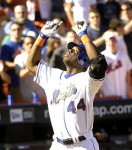Right about Santana, Wrong about Milledge

Today is the eighth anniversary of the Johan Santana trade. Over his tenure with the Mets, Santana pitched well to brilliantly when he was able to pitch.
Santana tried to will the Mets into the postseason in 2008. He pitched on three days rest on a bum knee and gave the Mets a brilliant outing, a complete game, three hit, nine strikeout, shut out. It would be the Mets last win at Shea Stadium. It would be his last great season, but not his last great moment. On June 1, 2012, he threw a 134 pitch no-hitter on a surgically repaired shoulder. The first in Mets history. It was effectively the end of his career.
The cost for all of this? Basically, it was Carlos Gomez. Yes, the same one. It’s interesting that it was Gomez because he wasn’t what the Twins initially wanted. They wanted Lastings Milledge.
At that time everyone wanted Milledge. The A’s wanted Milledge in exchange for Barry Zito. The Mets balked in 2006. They balked despite Pedro Martinez‘s injury problems. The Mets thought that highly of Milledge that they were willing to let him possibly stand in the way of a World Series title. He was considered that good. Except, unfortunately, he really wasn’t that good. His stock would go down to the point where he could only fetch Brian Schneider and Ryan Church. That’s a far cry from Barry Zito and Johan Santana.
The lesson here isn’t necessarily that you should always trade prospects. If that’s the case, the Mets wouldn’t have David Wright. No, the lesson is to make sure you are right before trading prospects.
The Mets were wrong about Gomez and Milledge. Most were. Now, Milledge is playing in Japan. Gomez is a two-time All Star. He’s a Gold Glove centerfielder. There are different times the Mets could’ve used him either as an outfielder (possibly avoiding the disastrous Jason Bay signing), or used him as a trade chip. Unfortunately, he wasn’t there because the Mets held onto the wrong prospect.
There are many lessons to learn with Santana, namely about abusing pitcher’s arms. The other lesson is that teams have to be right about their own prospects. By holding onto Milledge, the Mets might’ve lost out on a World Series in 2006. By being wrong about Milledge, the Mets lost out on Gomez’s career.
So whenever the Mets trade a prospect, we should look not just at the return, but also who they didn’t trade. As we saw with the Santana deal, you can still win a trade while still losing out on something else.